HOPE not hate uses cookies to collect information and give you a more personalised experience on our site. You can find more information in our privacy policy. To agree to this, please click accept.
When we published our first Fear and HOPE report in 2011, we found that a traditional left-right, class based political axis was failing to explain…
When we published our first Fear and HOPE report in 2011, we found that a traditional left-right, class based political axis was failing to explain peoples’ values, attitudes and voting behaviour. We found that attitudes in relation to culture, identity and nation were formed on the basis of a complex interplay of class, personal experience, life circumstance, and media consumption.
We worked with the polling experts Populus to develop a richer framework to better understand these issues. We split the population into six ‘identity tribes’; The two groups most open to immigration and supportive of multiculturalism are the Confident multiculturalists (22% of the population) and Mainstream Liberals (16%), while the two most hostile were Active Enmity (7%) and Latent Hostiles (13%). The two groups in the middle are the Culturally Concerned (16%), slightly older, more affluent voters who have cultural concerns around immigration and integration, and Immigrant ambivalence (26%), who are less concerned about cultural issues but worried about further immigration because of their economic anxieties.
These tribes were not static entities, and over time, we saw a shift in attitudes, with the share of the English population belonging to the two liberal ‘tribes’ growing from 24% to 39% in 2017. Over this period, we conducted four sets of Fear and HOPE polling and saw the middle ground shrink, while the proportion of the population identified in the two hostile ‘tribes’ remained constant. We saw growing polarisation and in particular, a hardening of attitudes towards Muslims in Britain.
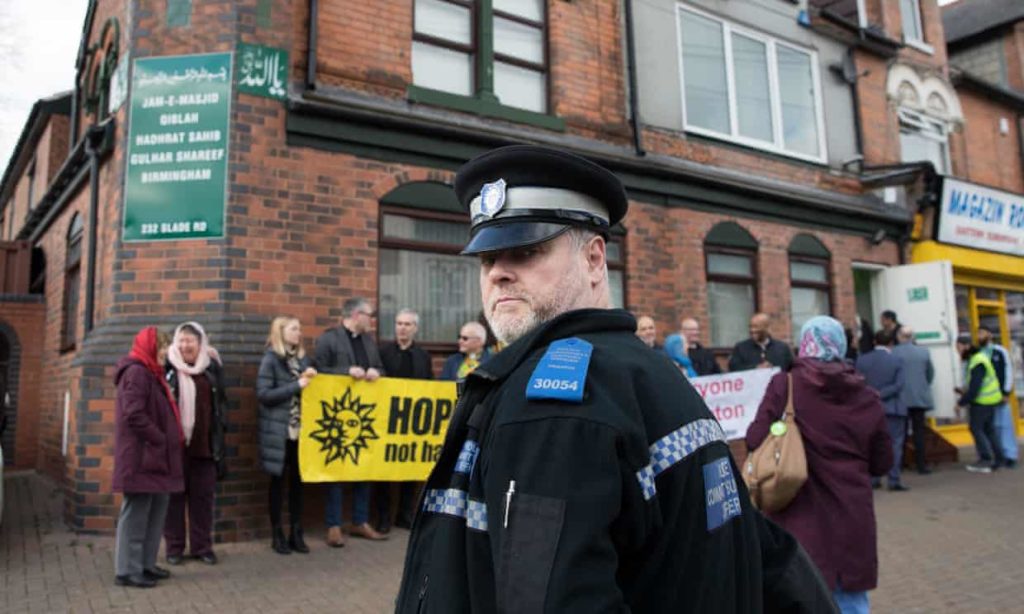
Major events and political changes all contributed to a shift in how people saw identity issues. In 2011, while people were still feeling the effects of the 2008 recession, immigration was being increasingly politicised as a politics of culture, identity and nation. The decline of the BNP saw the growth of the EDL and UKIP attempt to capture this appetite. By 2016, people were feeling more positive about a range of identity issues. At the same time, UKIP had surged to prominence, while the rise of ISIS and terror incidents in Woolwich, Paris and elsewhere have kept Islamic extremism in the headlines. In our 2017 report, we found the series of Islamist terror attacks in the UK had a profound impact on attitudes to race and faith.
However, the 2016 referendum is the event that had the most profound impact on identity politics and social divisions. The EU referendum exposed many pre-existing divisions in the UK, which held immigration as a key dividing issue. Leave appealed most to those sceptical about immigration, pessimistic about cultural change and assertive about English nationalism. Remain appealed most to those with a cosmopolitan worldview, pro-migration attitudes and optimism about the future.
Of course, those who voted Leave and Remain were in no way homogenous groups. But the 2016 referendum was unique in offering two clear cut camps where two very different visions of Englands clashed. By 2019, almost three years on from the referendum, people continue to associate more strongly with Remain or Leave than any other political or value-based position. We have also seen people’s values change as a result of which side of the referendum they most identify with.
Fear and Hope 2019 attempts to better understand the state of the nation in light of these changes, creating a new framework of ‘identity tribes’ to reflect how Brexit has changed Britain.
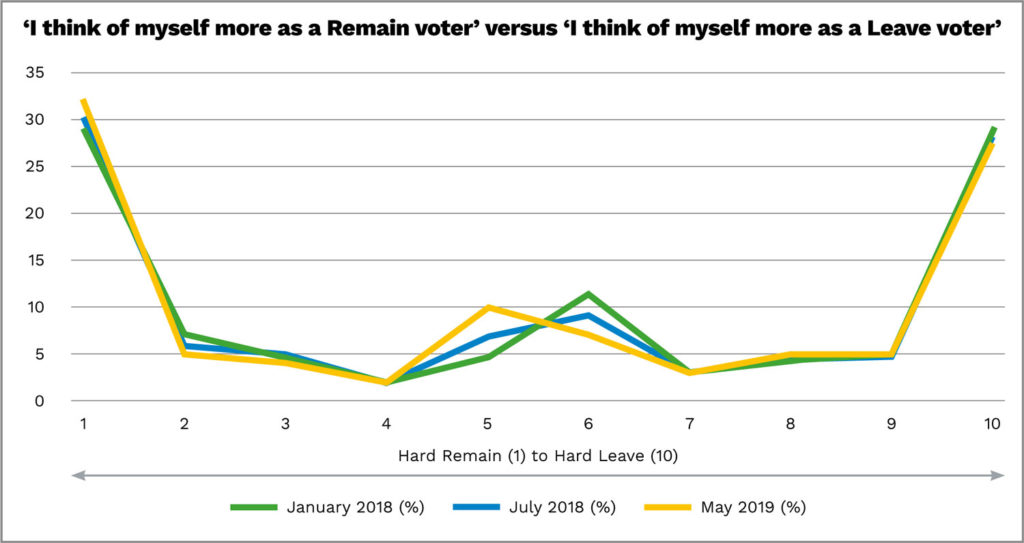
Understanding identity issues means we have to understand how people feel about Brexit. People have identified less and less with political parties since the 1970s, yet when asked if people think of themselves more as a Remain voter or a Leave voter, the vast majority of people see themselves strongly pinned to one side or the other. Being a leaver or a remainer has become part of our identity politics, one to which people feel an emotional bond, a frame through which we process information and make political choices.
When asked whether people consider themselves more of a Remain voter, or more of a Leave voter, the majority of people (60%) now see themselves at either extreme. While we have seen sizeable shifts over time in what people want from Brexit, there has been little shift in how people identify, with Remain voters in particular hardening their stance.
The strength of our Brexit identities is not imitated in regards to any other political allegiance. A huge 73% of our new poll said that none of the main political parties reflect what they think, a figure that has risen dramatically, from 61% in December 2018, to 68% in July 2018. It is now only a small minority of people, 27%, who are confident that at least one of the main political parties reflect what they think. There is very little warmth towards any of the major political parties in the UK, and less than 10% of people said that they closely identified with any leading figure of any of the main political parties.
The strength of opinion shown during and since the referendum over Britain’s membership of the EU was also about much more than how we feel about being European. Our relationship with Europe has always been complicated. Even before the referendum, fewer people in the UK felt any sense of European identity than in any other country in the European Union. The 2014 British Social Attitudes Survey found that just 15% of people in Britain identified as ‘European’, a figure that had changed little since 1996, when the question was first asked. Similarly, our Fear and HOPE studies have found that a sense of ‘European’ belonging has remained a minority view, with no significant change in the proportion of those identifying as European between 2011 and 2019- which now stands at just 7%.
Brexit has created a new identity politics, which has not just exposed pre-existing divisions, but offers a new, emotionally charged political structure through which we filter information and perceive the world around us.
Our Fear and HOPE reports have traced whether people feel optimistic or pessimistic about the future since 2011. We found this to be a key driver behind attitudes. People who were more optimistic about their own lives tended to hold more liberal views than those who felt pessimistic. People who were more optimistic tended to feel more in control of their own lives and were less likely to hold negative views toward immigration and multiculturalism.
Using the sophisticated data analytics technique MRP (multilevel regression with post-stratification) to map attitudes, we found that the most optimistic places in the country were areas within core cities and prosperous university towns. Eighteen of the most optimistic constituencies in February 2016 were London boroughs, with Bath and Edinburgh North and Leith also among the most hopeful for the future.
Conversely, we found pessimism in places where unemployment was more prevalent, where there were fewer opportunities and the standard of living was declining. Among the least optimistic in our 2016 pre-referendum poll were Grimsby, Rotherham, Hartlepool, Blaenau Gwent and Boston & Skegness. In all these areas less than 40% of people felt optimistic for the future- just 36% in Clacton, the least optimistic constituency in the UK.
The most pessimistic constituencies were also among those with the strongest Leave vote in the 2016 EU referendum, while the areas with the highest levels of optimism were among the strongest Remain voting constituencies.
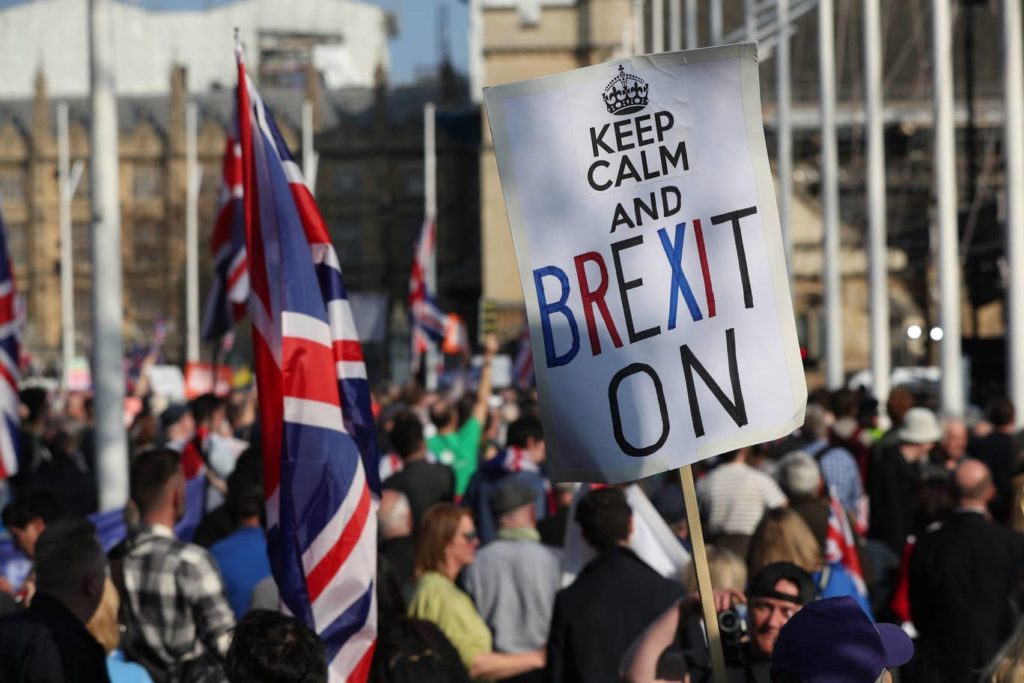
However, the EU referendum completely reversed these patterns of optimism and pessimism. Two years on, our July 2018 YouGov poll found that seventy-one percent (71%) of Remain voters said they felt pessimistic for the future, more than twice the proportion of Leave voters (35%). Eighteen percent (18%) of Remain voters felt that the next generation would have more opportunities than us, compared to 53% of Leave voters. Forty-six percent (46%) of Leave voters felt that Brexit would increase the economic opportunities for people like themselves, compared to just seven percent (7%) of Remain voters.
Our MRP constituency data found that areas with the greatest fall in optimism for the future between February 2016 and July 2018 were among the areas with the greatest Remain vote in the referendum. Hornsey and Wood Green became 23% more pessimistic over two years, Bristol West 22.3% more pessimistic, and Islington North 21.8% more pessimistic than in the months before the referendum.
Conversely, Leave voting areas saw a surge in optimism. Boston and Skegness, the constituency with the strongest Leave vote in the referendum was 15% more optimistic in our July 2018 poll, with other Brexit strongholds such as Clacton (14.6%), Castle Point (12.4%) and Louth and Horncastle (12.4%) all more optimistic for the future than in February 2016.
This crossing line in optimism and pessimism between Leave and Remain matters, because many of the places experiencing newfound optimism are among those most likely to feel the impacts of predicted economic downturn after the UK leaves the EU.
For example, in Dudley North. Economic projections suggest that the West Midlands economy could shrink by up to 13% after Britain leaves the EU, which would have a direct negative impact on people living in Dudley, where there are already pockets of acute deprivation. However, just 3.6% of Leave voters in Dudley North feel their economic situation would improve if the UK remained in the EU. An area where under 40% of people felt optimistic for the future in February 2016, by July 2018 optimism in the constituency has surged by 8%.
Our latest Fear and HOPE poll shows that we are overwhelmingly a country of pessimists. On the whole, the majority of Britain is pessimistic about the future (55%), with a minority saying they are optimistic (45%). However, the optimism gap between Leave and Remain voters is closing, with remain voters more pessimistic (60%) than Leave voters (51%). Delays to the UK’s departure from the EU have dampened some of the optimism Leave voters felt in July 2018, when only 35% of Leave voters felt pessimistic. Remain voters too, are recovering from their initial shock, 11% more optimistic than they were ten months prior.
However, we remain divided on our expectations from Brexit. 82% of remain voters think that the British economy as a whole would be better if the UK remained in the EU, while 74% think their own economic prospects would be better and 82% think there would be better opportunities for children growing up today.
By contrast, 66% of Leave voters think that the British economy as a whole would be better if the UK leaves the EU, while 46% think their own economic prospects would be better and 37% think it wouldn’t make much difference either way. 56% think there would be better opportunities for children growing up today if the UK goes ahead with Brexit.
Our Brexit identities continue to shape how we feel about the future, and how we filter information, with Remain voters more likely to believe information about projected economic downturn and job losses, and Leave voters unlikely to think this is true.

Our December 2018 poll conducted by Populus found that 65% of people think that Britain is now more divided as a result of the referendum. Only 12% of the total population disagreed that Brexit has made us more divided. The proportion of people who are concerned that Brexit is feeding prejudice and division and taking our country backwards rose over a 6 month period, from 57% in July 2018 to 62% in December 2018. Only a quarter of people disagreed (26%).
Indeed, we have seen a rise in recorded hate crime since the 2016 vote, and in our own work in communities across the country, we have witnessed discrimination enabled not just against EU migrants but also British Muslims. Many saw the anti-migrant Leave campaign, which also played on anti-Muslim messaging around refugee flows through Europe and Turkey’s membership of the EU, as an enabler of prejudice and racism. However, it is important to separate these sentiments and actions from all Leave voters.
Nonetheless, the strength of our Brexit identities has also enabled animosity towards voters on the other side of the referendum debate. Slurs about ‘Remoaners’, a term used by right-wing media and Eurosceptic agitators to describe those who are outraged and frustrated at the outcome of the EU referendum, has engrained a binary and a discourse of division between those who voted to leave the EU and remainers, depicted as middle class, out of touch, and self-interested.
In focus groups on Brexit that we ran through the summer of 2018, we found that some Leave voters felt belittled by remain voters, and felt that warnings from the remain side about economic decline was a ‘sore loser’ response just to protect their own interests. Many described Remain voters as elite, self-righteous, cosmopolitan city residents who were only concerned about potential economic decline because it might affect themselves:
“The only reason all these affluent people are up in arms now is because it’s the first time their boat’s been rocked a bit and they’re scared”
“It was when Obama started telling us to remain in the EU. I don’t like anyone telling me what to do. And what’s it got to do with him?” Peterborough: Leave voters
“Now all these things come up on the news, trade and that…but they’re making it more complicated because they don’t want to leave, ‘cos these big shots in London are gonna lose the most, not the working class.“ Blackpool: Labour Leave voter
Anger towards remain supporting politicians, and animosity towards ‘remoaners’ is just one side of the coin. We have also noted increasing intolerance from progressives with strong Remain identities, aimed towards Leave voters.
In our Brexit focus groups, most people were measured and respectful of those who felt differently about Brexit to themselves, but we frequently heard Remain voters dismiss those who had voted to leave the EU as racist, inward-looking and uninformed.
There were also occasional sneering comments from Remain voters that maybe those who voted Leave were ‘getting what they deserved’, that they were ‘turkeys voting for Christmas’, in response to suggestions Leave voting communities may be made poorer by any economic decline as a result of Brexit.
In our 2016 Fear and Hope study, conducted immediately after the referendum, we found the two most liberal tribes were overwhelmingly furious with the tone of the Referendum campaign and the result. These factors had reinforced and hardened their own support for immigration and multiculturalism, reflected in even stronger views on these issues in our poll. Horrified at the result and the increase in racist incidents, the liberal 48% appeared to have become the angry outsiders.
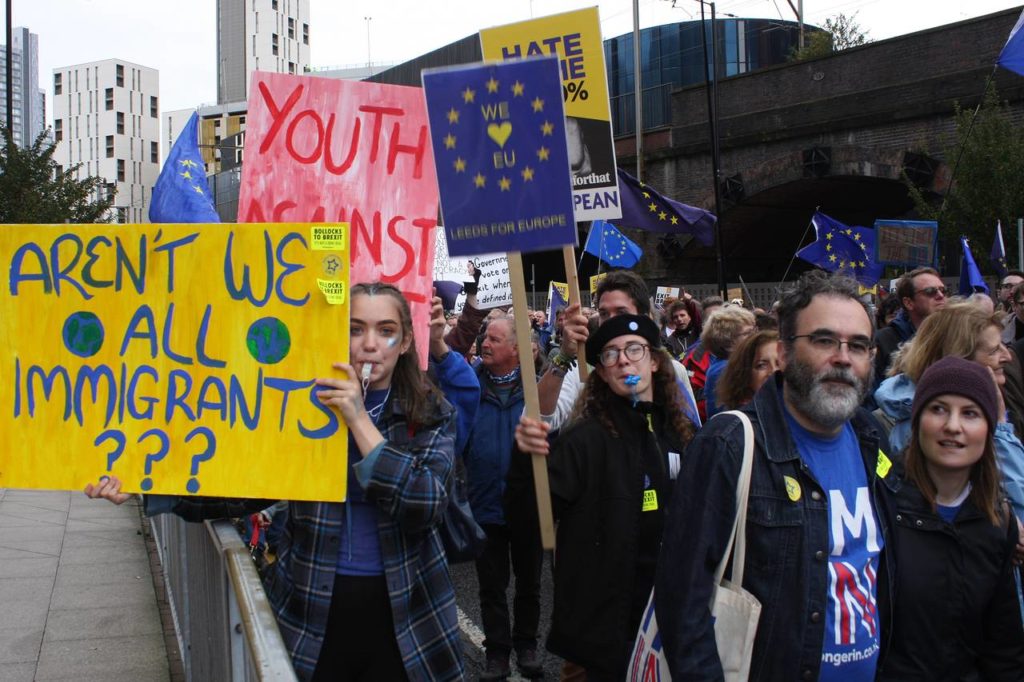
Immediately after the referendum, we saw the views of the immigration-sceptic tribes soften on many social issues, arguably less angry than they were a few months, and less angry than they would have been if the UK had voted to remain in the UK. At the same time, we saw the attitudes of the two liberal tribes reinforce and harden their support for immigration and multiculturalism, overwhelmingly furious with the tone of the Referendum campaign and the result.
It was clear that Brexit had shifted our perceptions of society, as we aligned closer to our values. Between February 2016 and July 2017, 20% fewer of those in the two liberal tribes, most likely to have voted to Remain in the EU, claimed not to know anyone Muslim well, despite there being very little demographic change over this time. There were less significant shifts among the other social groups- just 6% fewer among the Active enmity tribe claimed not to know anyone Muslim well over the same time period.
Brexit exposed many pre-existing social divisions, but it also added a new dimension to our identities that determines which information we choose to believe and how we see others around us. Our 2019 Fear and HOPE report introduces our seven new tribes to better understand how Brexit has changed Britain.
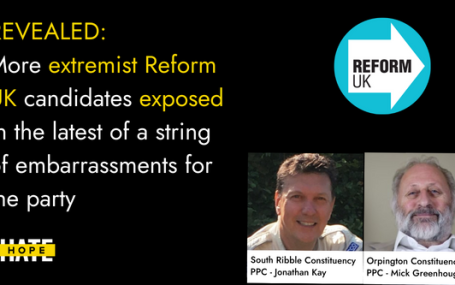
HOPE not hate reveals two more extremist candidates from Reform UK, in the latest of a string of embarrassments for the party UPDATE: Just hours…